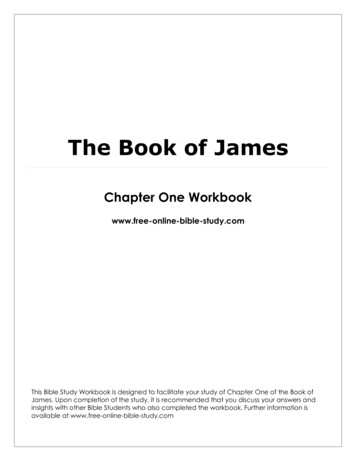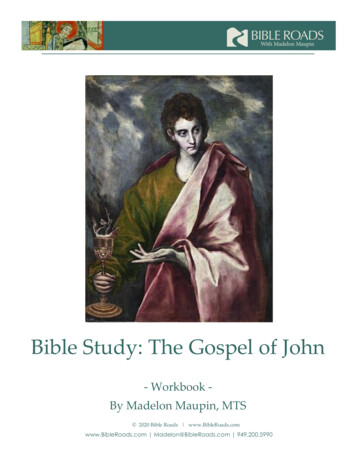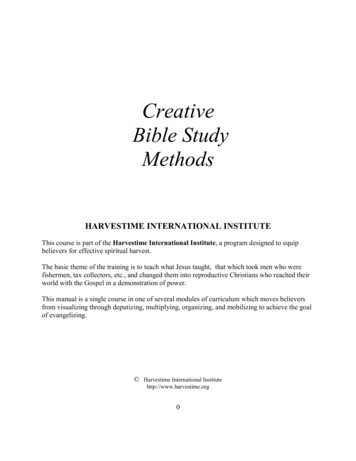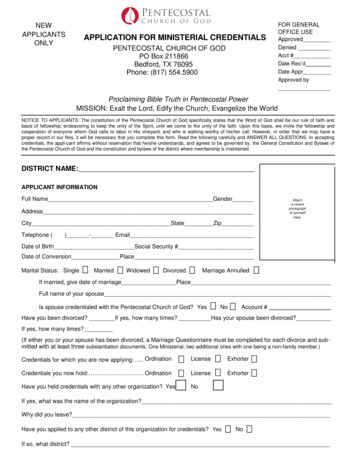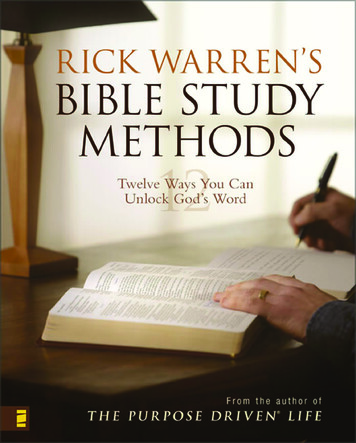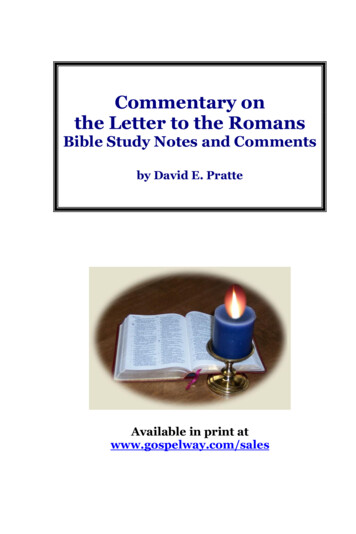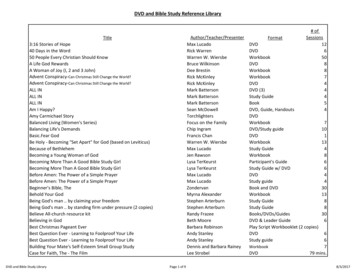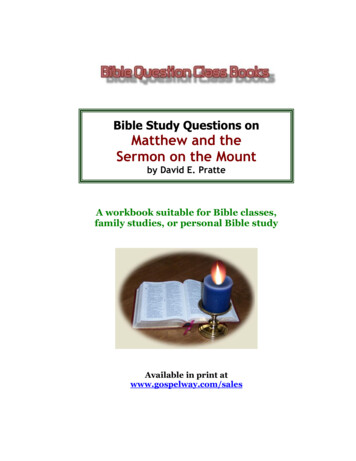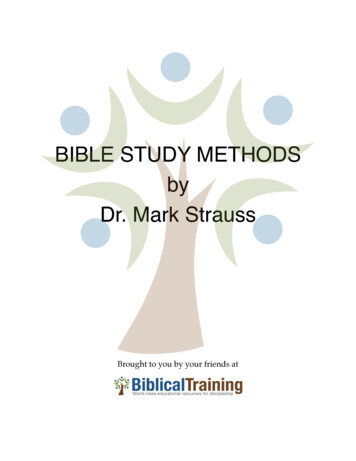
Transcription
BIBLE STUDY METHODSbyDr. Mark StraussBrought to you by your friends at
Bible Study MethodsTable of ContentsLesson 1 Introduction to Hermeneutics (Part 1) .3Section 1: Presuppositions for Interpretation .3Section 2: The Nature of the Bible: Unity and Diversity .5Lesson 2 Introduction to Hermeneutics (Part 2) .9Lesson 3 Four Key Principles of Exegesis .14Lesson 4 Exegesis Steps (Part 1).18Lesson 5 Ten Steps for Exegesis (Part 2).24Lesson 6 Word Studies .30Lesson 7 Application .34!2
Bible Study MethodsLesson 1 Introduction to Hermeneutics (Part 1)Section 1: Presuppositions for InterpretationSECTION OVERVIEWThis is a course in basic introduction to the Bible. We call the interpretation of the Bible“hermeneutics“ and so this is a course in introductory hermeneutics. God’s Word, theBible, came to us in human language and in human culture and human contexts and weunderstand God's Word by reading it within that particular culture and context inwhich it was given. We are going to divide the course up into beginning withintroductory issues and the first issue we are going to cover today are some of ourpresuppositions, the presuppositions we bring to the table to interpret the Bible.THE BIBLE IS GOD’S WORD1. The Bible is inspired by God.a. Claimed implicitlyb. Claimed explicitly2. The Authority of Scripture over a. Personal experienceb. Reasonc. Tradition or dogma!3
Bible Study MethodsTHE INTERPRETER MUST BE BORN AGAIN2 Corinthians 4:41 Corinthians 2:14Hebrews 4:12THE INTERPRETER MUST BE FILLED WITH THE SPIRITJohn 16:13InspirationIllumination!4
Bible Study MethodsSection 2: The Nature of the Bible: Unity and DiversitySECTION OVERVIEWAs we begin the process of interpreting God's Word the first thing we have to ask iswhat is the Bible. We can only read and understand the Bible if we understand itsnature and so this lecture is entitled The Nature of the Bible and I would subtitle itUnity and Diversity. It seems to me the best way to comprehend, the best way tounderstand the nature of the Bible is with the terms unity and diversity. Together thesetwo terms really help us to understand what the Bible is and how we ought to approachit.DIVERSITY OF THE BIBLE1. Kinds of Diversity2. Implications of Diversitya. We must adapt methodology for various kinds of literature.b. We must recognize the progress of revelation.c. We must allow the biblical writers to speak for themselves.!5
Bible Study Methods3. Biblical TheologyDefinitionThree StepsUNITY OF THE BIBLE1. Unity of ThemeLuke 24Jesus Christ is the central theme of Scripture.2. Implications of UnityThe Bible is one story.A systematic theology becomes a possibility.!6
Bible Study MethodsREFLECTION QUESTIONS1. What other presuppositions or biases do you have about the Bible? How do ourpresuppositions effect the way we interpret the Bible? Is it possible to be completelyobjective in our interpretations? Are there some biases we should try to minimize?2. Why does it matter that the Bible is the Word of God? What if it were merely ahuman book. How would that effect how we interpret and apply it? How does thestyle of the human writers effect our interpretation of a particular passage?3. How do you allow the Bible to become authoritative over your life? What role doesScripture play in your daily decision-making? What role should it play? What roledoes it play in your church? How do we keep tradition from trumping Scripture?4. Can someone who isn’t a believer understand any part of Scripture? What role doesfaith play in interpretation of the Bible? What role does it play in application? Whatis the difference between understanding and application? How does the Spirit helpyou in this process of interpreting and applying God’s Word?5. What is the difference in taking a passage literally vs. taking it figuratively? Does iteffect how we apply a particular passage? Are there different ways to define theword “literal?” What should be our overall approach to Scripture?6. What is your general view about how the Old Testament relates to the NewTestament? Have you considered one more important than the other, or spent moretime reading one over the other? How do we apply Old Testament passages thatdon’t seem to relate to present day? What does it mean to let the biblical writerspeak for himself?7. Take some time to reflect on how the Bible is a unified whole. How have you seenJesus in the Old Testament? Do you tend to see too much or too little of Jesus in theOld Testament? What didn’t the Jews of Jesus’ day (particularly those on the road toEmmaus) not get that the OT was all about Jesus? Why do we still have a tough timegrasping that today?8. What difference does it make that the Bible is one story? How does that truth effectthe way you interpret a particular passage of Scripture? How are our personalstories today affected by the grand story of Scripture? Does it effect how we live ourlives?!7
Bible Study MethodsRECOMMENDED READINGHow to Read the Bible in Changing Times: Understanding and Applying God’s Word Today, byMark L. Strauss, pp. 1-12, 41-67.How to Read the Bible for All Its Worth, Fourth Edition, by Gordon D. Fee and DouglasStuart, pp. 21-35.!8
Bible Study MethodsLesson 2 Introduction to Hermeneutics (Part 2)LESSON OVERVIEWHermeneutics is the science and art of biblical interpretation. The goals of exegesis areto determine the meaning of a passage in its original context, and to determine thesignificance of the passage for today.REVIEW OF LESSON ONEHERMENEUTICSDefinition – the science and art of biblical interpretation.Why do we need it?THE GOALS OF HERMENEUTICSExegesis: To Determine the Meaning of a Passage in Its Original Context!9
Bible Study MethodsClarifications1. The original meaning refers to the author’s intended meaning.2. Meaning is text-centered – the author’s intent as discernible from the text andits context.3. The text is historically positioned.Bridge IllustrationContextualizationWhy do we need contextualization?OT CommandsExodus 29:38Deuteronomy 21:18!10
Bible Study MethodsLeviticus 19:19Exodus 35:2NT Commands1 Peter 5:141 Corinthians 11:51 Timothy 5:23Charlie Brown CartoonThe Bible was not written to us, but it was written for us.Contextualization vs. Application!11
Bible Study MethodsAVOIDING SHORTCUTSApplication without ExegesisSubjectivityProof TextingExegesis without ContextualizationNot allowing the Bible to transform your lifeConfusing eternal principles with cultural applicationsMagic answer book or verse-for-the-day syndromeSUMMARY!12
Bible Study MethodsREFLECTIONS QUESTIONS1. Why do we need to interpret the Bible? How would you explain the importance ofinterpretation to a friend who says they just need to read the Bible?2. Why is important to determine the author’s intended meaning? How can we knowthat we have interpreted a passage correctly? Should we leave interpretation up tothe “professionals” or should everyone do it?3. Why do we need to contextualize? What are some of the dangers of leaving out thestep of contextualization? What are some of the dangers of failing to do exegesisfirst? Which step are you more likely to leave out? What are some safeguards thatyou could put in place to avoid skipping a step in the hermeneutical process?4. Draw out the bridge illustration and explain it to a friend. Be sure to talk about thechallenges that you face in doing exegesis and contextualization, and where theyboth fit in the bridge illustration.RECOMMENDED READINGHow to Read the Bible in Changing Times: Understanding and Applying God’s Word Today, byMark L. Strauss, pp. 13-40.How to Read the Bible for All Its Worth, Fourth Edition, by Gordon D. Fee and DouglasStuart, pp. 57-92.!13
Bible Study MethodsLesson 3 Four Key Principles of ExegesisLESSON OVERVIEWIn this session we are going to be looking at what we call the canon of scripture, thequestion of what books should be included as part of the Bible, as part of inspiredscripture and why do we have the sixty-six books, thirty-nine books of our OldTestament and twenty-seven books of our New Testament in our Bibles, why these andno others. That is the question of canon.REVIEW OF PREVIOUS LESSONSFOUR PRINCIPLES1. Determine the Author’s Intended MeaningDouble Meaning?Word PlayDual Fulfillment of Prophecies!14
Bible Study Methods2. The Meaning of a Text is Genre Dependent3. Context is the Key to InterpretationHistorical ContextGeneral Historical ContextGeographical ContextHistorical Political ContextReligious SituationMark 12Specific Historical Context!15
Bible Study MethodsLiterary ContextWordsSentencesParagraphsBookBroader Context4. The Text Itself Must Be Given PriorityA spiral from inductive to deductive reasoningA spiral from text to context!16
Bible Study MethodsClarification: What about interpreting the Bible “literally”?REFLECTION QUESTIONS1. Why is it important to determine the author’s intended meaning rather thanbringing your own meaning to the text? How does this principle help us when wecome to controversial passages or topics in Scripture, e.g. the role of women inchurch leadership or same-sex attraction?2. Why is determining the genre so important? Think of some modern-day examples ofwhere the genre affects the meaning of something that is written or spoken. Are wemore tuned in to the genre today than when we read Scripture?3. When someone says that what they said was taken out of context, what do theyusually mean by that? Scripture was given to us in specific historical and socialcontexts, how does this affect how we interpret certain passages?4. Why must the text always be given priority? What are some safeguards you couldput in place in the interpretive process to make sure the text determines the meaningof the passage?5. What do you think about using the word “literal” when discussing the process ofinterpretation? What are the various ways that you have seen it used? What wouldbe a better term to use?RECOMMENDED READINGHow to Read the Bible in Changing Times: Understanding and Applying God’s Word Today, byMark L. Strauss, pp. 69-92.How to Read the Bible for All Its Worth, Fourth Edition, by Gordon D. Fee and DouglasStuart, pp. 57-73.!17
Bible Study MethodsLesson 4 Exegesis Steps (Part 1)LESSON OVERVIEWDr. Strauss explains the first four (of the ten) steps for English Bible exegesis: 1) identifythe genre, 2) get the big picture, 3) develop a thesis statement and 4) outline theprogress of thought.REVIEW AND INTRODUCTIONSTEP 1: IDENTIFY THE GENRE (LITERARY FORM)!18
Bible Study MethodsSTEP 2: GET THE BIG PICTURE: ESTABLISH THE HISTORICAL ANDLITERARY CONTEXTHistorical ContextEpistleGospelProphetic LiteratureLiterary Context1. Break the book down into each of its main paragraphs.2. Group those related paragraphs into sections.3. Group the sections into even larger sections.4. Develop an outline for the passage.!19
Bible Study MethodsSTEP 3: DEVELOP A THESIS STATEMENTThe Problems of Too Little and Too MuchBig Idea: The Subject and the ComplementPractice: Psalm 23Hints for Finding the Big Idea:1. What one theme gives this passage unity?2. Look for a theme that occurs repeatedly, especially at the beginning and the end.3. Outline the passage.4. Test out the theme. Does every verse relate?5. Turn your subject into a question and the complement should answer thisquestion.!20
Bible Study MethodsPractice: Philippians 1:12-18STEP 4: OUTLINE THE PROGRESS OF THOUGHT IN THE PASSAGEAn Outline Should 1) Relate Directly to Your Thesis Statement2) Clearly and Accurately Explain the Progress of the ArgumentTwo Main Kinds of Outlines1. Parallel Outline2. Progressive Outline!21
Bible Study MethodsPractice: Romans 12:1-2Practice: Mark 2:13-17REFLECTION QUESTIONS AND PRACTICE1. Why is it important to know the literary form of a passage? What are the differencesin the way parables and historical narrative communicate truth? How does thatchange what you are looking for in a particular passage? Is one more “truthful” thananother?2. How are both inductive and deductive approaches to reading and study helpful?How do they complement one another? Try reading through a short book of theBible (e.g. Philemon, Jude, or Ruth) and outlining the main idea and flow of thoughtfor the book.3. Have you seen examples of a pastor preaching too little or too much of a text? Whatare some of the dangers if we preach/teach too much or too little? What are somesafeguards for make sure we preach/teach the text?!22
Bible Study Methods4. Practice developing a big idea and an outline for each of the following passages:Psalm 23, Mark 2:13-17, Romans 12:1-2, and Philippians 1:12-18.5. Try to develop a big idea and outline for the book of Jude.RECOMMENDED READINGBiblical Preaching: The Development and Delivery of Expository Messages, by Haddon W.Robinson, pp. 31-50.!23
Bible Study MethodsLesson 5 Ten Steps for Exegesis (Part 2)LESSON OVERVIEWThe final six steps in exegesis process are consulting secondary sources, analyzingsyntactical relationships, analyzing key terms and themes, resolving interpretive issuesand problems, evaluating your results from the perspective of wider contextual andtheological issues and summarizing your results.REVIEW OF THE FIRST FOUR STEPS1. Identify the Genre2. Get the Big Picture3. Develop a Thesis Statement4. Outline the Passage!24
Bible Study MethodsSTEP 5: CONSULT SECONDARY SOURCES (A GOOD COMMENTARY)Expository CommentariesCommentaries and Their Proper UseDifferent Types of CommentariesCommentary SeriesEvaluating and Choosing CommentariesTips for Using Commentaries!25
Bible Study MethodsSTEP 6: ANALYZE SYNTACTICAL RELATIONSHIPSSTEP 7: ANALYZE KEY TERMS AND THEMESSTEP 8: RESOLVE INTERPRETIVE ISSUES AND PROBLEMSTypes of IssuesTextual ProblemsGenre Identification QuestionsMeaning of WordsSyntactical QuestionsHistorical ReferenceApparent Contradictions!26
Bible Study MethodsPrinciples for Resolving Problems1. Correctly identify the literary genre.2. Carefully examine the context.3. Consult outside sources.4. Keep an open mind.5. Pray about the passage.STEP 9: EVALUATE YOUR RESULTS FROM THE PERSPECTIVE OFWIDER CONTEXTUAL AND THEOLOGICAL ISSUESContext of the BookContext of the Author’s Writings!27
Bible Study MethodsContext of Broader Biblical TeachingSTEP 10: SUMMARIZE YOUR RESULTSREFLECTION QUESTIONS1. What is the ultimate goal of Bible Study? How can you make sure Bible Studydoesn’t become purely an academic exercise where your only goal is to know more?How does studying with others help in this process?2. Who are the leaders or mentors in your life whose opinions you trust? Do you havea person whom you regularly consult on the meaning of Bible passages? What is theproper role of commentaries in the Bible study process? How is a commentary like atrusted friend or mentor? How is it different?3. Reflect on your own theological or interpretive biases. What is the best way toidentify your own biases? What are some ways to make sure you are open to viewsother than your own? Are there limits to “listening to the other side?”4. What is the role of prayer in Bible study? Spend some time in prayer about thepassage you are currently studying. What are some ways to make prayer a regularpart of your study time?5. Choose one of the following passages and begin to work through the ten steps ofexegesis: Psalm 23, Mark 2:13-17, Romans 12:1-2, and Philippians 1:12-18.!28
Bible Study MethodsRECOMMENDED READINGOld Testament Commentary Survey, 5th. Ed., by Tremper Longman III.New Testament Commentary Survey, 7th. Ed., by D. A. Carson.How to Read the Bible for All Its Worth, Fourth Edition, by Gordon D. Fee and DouglasStuart, pp. 275-290.!29
Bible Study MethodsLesson 6 Word StudiesLESSON OVERVIEWWord studies are helpful tools you can use to help you better understand the Bible. It isimportant to make sure your conclusions are accurate and that you use yourconclusions in an appropriate way.BIBLICAL AUTHORITY AND THE ORIGINAL TEXTBASIC PRINCIPLES FOR BIBLICAL WORD STUDIESA. Words generally have a semantic range, not one all-encompassing “meaning.”B. Context determines which particular “referent” or “sense” within this semanticrange the author intended.!30
Bible Study MethodsC. Words normally have only one “sense” in any particular literary context.D. The meaning of words often changes over time.E. Etymology is never a reliable guide to meaning.F. Two Steps for Word Studies1. Determine what the word can mean.2. Examine the context to determine which of its possible senses the word means.AVOIDING WORD STUDY FALLACIESA. The “root meaning” fallacyB. The “etymology” fallacy!31
Bible Study MethodsC. The “anachronistic meaning” fallacyPRINCIPLES TO AVOID WORD STUDY FALLACIESA. Meaning is determined by context, not word roots.B. Study sentences, not Greek words.C. Read for the big idea, not for the hidden meaning.D. Compare various English versions.E. Check the better commentaries.!32
Bible Study MethodsTHE BEST TOOLS FOR WORD STUDIESREFLECTION QUESTIONS1. What has been your response when a pastor or teacher refers to the originallanguages during a sermon or lesson? Reflect on the positive and negative aspects ofreferring to Greek and Hebrew. Do the benefits outweigh the dangers? Is it moreabout the heart motivation of the preacher/teacher?2. What is the value of doing word studies? Can too much emphasis be placed on themeaning of words? How do you strike a proper balance in your studies?3. What are some word study errors that you have personally heard? What does it doto the authority of the teaching when someone improperly attributes the meaning ofa particular word to its “root meaning” or “etymology”? Write down somesafeguards for avoiding the three fallacies mentioned in this lesson.4. Choose a significant word from one of the following passages and a do a word studyusing the techniques and tools that Dr. Strauss mentioned in this lesson: Psalm 23,Mark 2:13-17, Romans 12:1-2, and Philippians 1:12-18.RECOMMENDED READINGMounce’s Complete Expository Dictionary of Old and New Testament Word, by William D.Mounce, Editor.Exegetical Fallacies, 2nd. Ed., by D.A. Carson.Biblical Words and Their Meaning: An Introduction to Lexical Semantics, by Moisés Silva.!33
Bible Study MethodsLesson 7 ApplicationLESSON OVERVIEWIn this lesson, Dr. Strauss discusses two extremes to avoid when applying Scripture. Healso gives us five principles to guide our contextualization of a particular passage.INTRODUCTION AND REVIEWTWO EXTREMES TO AVOID1. Imitating Biblical Culture Exactly2. Letting the Culture Govern the Message!34
Bible Study MethodsPRINCIPLES OF CONTEXTUALIZATION1. Proper contextualization begins with sound exegesis.2. All Scripture is authoritative, because it is inspired by God.3. Scripture can be applied at the surface level, or at the level of principle.4. Individual statements must be placed in the broader context of Scripture.a. Is the command inherently moral?b. Does the context give indications that the passage is above culture?c. Do we share comparable particulars?!35
Bible Study Methodsd. Is the command connected to cultural practices current in the first century but notpresent today?e. What cultural options were open to the writer?f. What is the ultimate purpose of this command in its cultural context?5. Individual statements must be placed in the broader context of Scripture.a. Is all of biblical teaching uniform or does it reflect differences of perspective?b. Is this part of core biblical teaching or is it peripheral?SUMMARY!36
Bible Study MethodsREFLECTION QUESTIONS1. Of the two extremes to avoid in application, too much in biblical culture or too muchin our own culture, is one more dangerous than the other? Reflect on the variousdangers inherent in each extreme and how you might avoid them in yourapplication.2. What is your view on the authority or role of the Old Testament law and itsobligations for the believer? How have Dr. Strauss’ principles for application helpedyou in your thinking of the place of the law in today’s culture?3. What do you think is harder, understanding Scripture or applying it to your life?How are the two related? How would you explain to a friend the importance ofapplying all of Scripture, even the lesser-known portions?4. Choose one or more of the following passages and come up with two or threeapplications for each: Psalm 23, Mark 2:13-17, Romans 12:1-2, and Philippians1:12-18.RECOMMENDED READINGHow to Read the Bible in Changing Times: Understanding and Applying God’s Word Today, byMark L. Strauss, pp. 207-252.How to Read the Bible for All Its Worth, Fourth Edition, by Gordon D. Fee and DouglasStuart, pp. 74-92.!37
Bible Study Methods Lesson 1 Introduction to Hermeneutics (Part 1) Section 1: Presuppositions for Interpretation SECTION OVERVIEW This is a course in basic introduction to the Bible. We call the interpretation of the Bible “hermeneutics“ and so this is a course in introductory hermeneutics. God’s Word, theFile Size: 214KB
